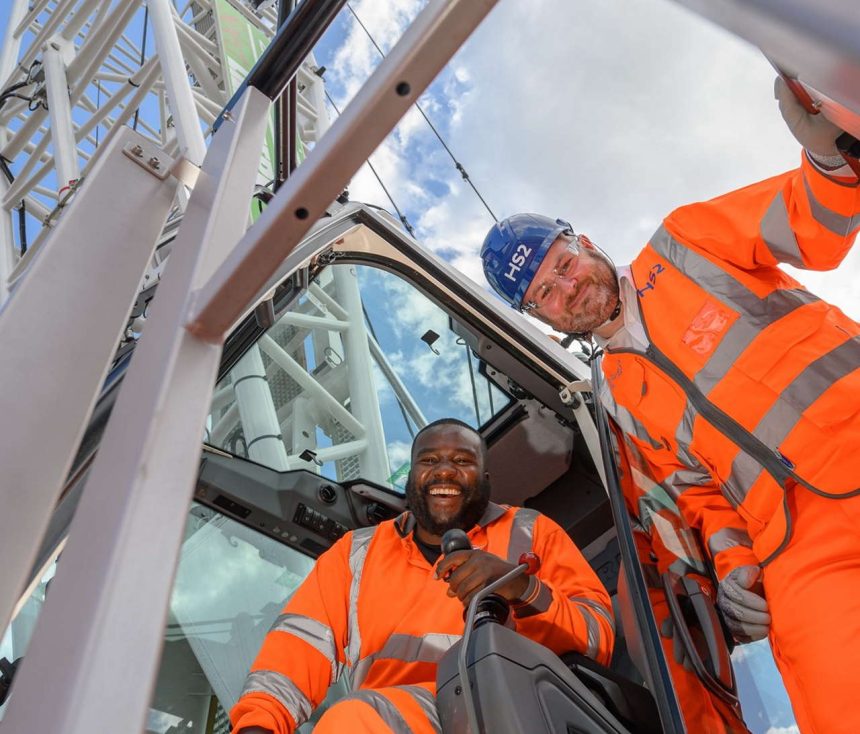One of the construction sites being used to build HS2 has become its first site that is completely diesel-free.
HS2's civils contractor, Skanska Costain STRABAG joint venture (SCS JV), has introduced a range of diesel-free technologies and greener equipment at the Canterbury Road Vent Shaft site in South Kilburn. Innovations at the site include: one of the UK's first 160 tonne emissions-free fully electric crawler cranes; use of biofuels (hydrogenated vegetable oil) to power plant and machinery on site; an electric compressor; and access to mains power on a 100% renewable energy tariff.
Earlier this year, HS2 Ltd announced that the project aims to be net-zero carbon from 2035, with the target of achieving its first diesel-free construction site in 2022, and all its construction sites being diesel-free by 2029.
HS2's Net Zero Carbon Plan sets out how HS2 will achieve new carbon reduction milestones, support the decarbonisation of the UK construction sector, and reduce the carbon footprint of the programme.
Innovations being trialled and introduced on other HS2 sites to cut carbon across the whole of the route include:
- a ‘Clean Air Gas Engine' funded through Innovate UK and led by OakTec that replaces diesel power with ultra-low (bio-LPG) emission engines in Advante Welfare units and standalone units.
- ‘EcoNet', developed by Invisible Systems, Balfour Beatty, and Sunbelt, which controls and reduces energy output from key appliances, reducing power demand by 30%;
- non-road mobile machinery retrofit solutions which adds pollution control equipment onto older vehicle;
- CESAR Emissions Compliance Verification which is a resilient system to show the EU Stage engine emission class of all construction plant;
- proactive dust management solutions that reduce the effects of on-site activities;
- fully electric renewable energy using solar and wind to power noise and air quality monitors, site security cameras, and site briefing areas, and solar pods to power sites by combining solar PV, battery storage, and a backup generator;
- trialling hydrogen technology across sites considering both fuel-cell technology and combustible hydrogen solutions.
HS2 Minister Andrew Stephenson said: “HS2 is boosting transport across the UK, creating thousands of jobs and levelling up communities throughout the North and Midlands, all while leaving the environment better off than how we found it.
“This, the first of many diesel-free sites, is another example of how the country's biggest infrastructure project not only delivers on its commitment to be Net Zero from 2035 but is a pioneer in leading the whole industry to cleaner, greener construction.”
Peter Miller, HS2's Environment Director said: “We're delighted to reach this key milestone in our Net Zero Carbon Plan. HS2 is playing a major role in the decarbonisation of the construction industry, collaborating with the industry and our supply chain to accelerate innovation in low-carbon technologies. Reducing emissions and improving air quality on HS2 construction sites is crucial for both the environment and surrounding communities.”
James Richardson, Managing Director of SCS said: “We're thrilled that Canterbury Road Vent Shaft has become the first diesel-free site on the HS2 project. We're working hard with our supply chain to introduce renewable energy, green hydrogen, and sustainable biofuels to help us remove diesel entirely from our sites by 2023.”

Yet again we see organisations boasting about the “100% renewable electricity” they either supply or use. I’m afraid there is no other way to call this description than a lie. If the organisation is connected to the National Grid then it will supply or use exactly the same mix of electricity generation sources as everyone else connected to the grid. In the UK, at least half of that generation is from natural gas – and it is significantly more than this when the wind isn’t blowing and the sun isn’t shining. The only way users could have “100% renewable electricity” would be if electrons from wind and solar generators could be trained to flow only to those users. Even in the highly unlikely event of that being achieved, other users would anyway then be deprived of their share of the renewable electricity.